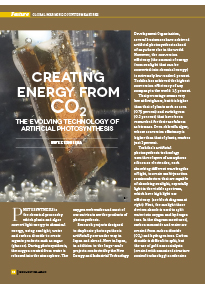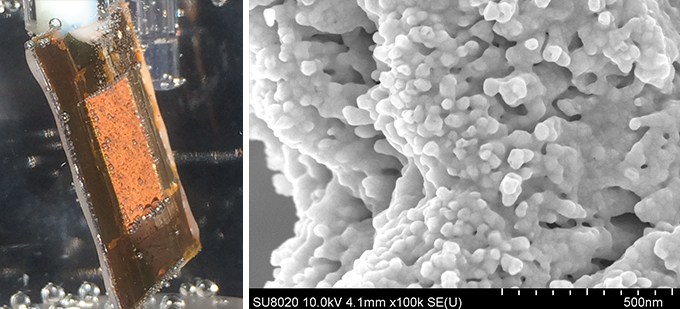Home > Highlighting JAPAN >Highlighting Japan February 2015>Global warming countermeasures
Highlighting JAPAN

Global warming countermeasures
Creating Energy from
CO2
The evolving technology of artificial photosynthesis

Photosynthesis is the chemical process by which plants and algae convert light energy to chemical energy, using sunlight, water and carbon dioxide to create organic products such as sugar (glucose). During photosynthesis, the oxygen created from water is released into the atmosphere. The oxygen we breathe and most of our nutrients are the products of photosynthesis.
Research projects designed to duplicate photosynthesis artificially are under way in Japan and abroad. Here in Japan, in addition to the large-scale projects conducted by the New Energy and Industrial Technology Development Organization, several businesses have achieved artificial photosynthesis ahead of anywhere else in the world. However, the conversion efficiency (the amount of energy from sunlight that can be converted into chemical energy) is extremely low: under 1 percent. Toshiba has achieved the highest conversion efficiency of any company in the world: 1.5 percent.
That percentage seems very low at first glance, but it is higher than that of plants such as corn (0.79 percent) and switchgrass (0.2 percent) that have been researched for their usefulness as biomass. Even chlorella algae, whose conversion efficiency is higher than that of plants, reaches just 2 percent.
Toshiba’s artificial photosynthesis technology uses three layers of amorphous silicon as electrodes, each absorbing different wavelengths of light, to create multi-junction semiconductors that are capable of absorbing sunlight, especially light in the visible spectrum, which have high light use efficiency (see block diagram at right). First, the sunlight these devices absorb is used to split water into oxygen and hydrogen ions. In the diagram mentioned, carbon monoxide and water are created from carbon dioxide (CO2) and hydrogen ions. Carbon dioxide is difficult to split, but the use of gold nanocatalysts (created with nanosized structure control technology) accelerates the reaction, increasing energy conversion efficiency.
This makes it possible to create methanol, which is used as a raw material for fuels such as gasoline, as well as for resins and adhesives, from the carbon monoxide generated. Toshiba’s goal is for the system to be compatible with the carbon dioxide separation and recovery systems frequently installed at facilities with high carbon dioxide emissions, such as thermal power stations and factories. If this succeeds, carbon dioxide that was once released into the atmosphere can be used to create energy instead.
For example, at a facility that emits thirty tons of carbon dioxide per day, converting a tenth of that (three tons of carbon dioxide) into energy via artificial photosynthesis at a solar-to-chemical energy conversion rate of 10 percent would entail an area of over ten thousand square meters to absorb sunlight. Even so, the process would be 140 times more efficient in absorbing carbon dioxide than a cryptomeria forest of the same size (a hectare of cryptomeria absorbs carbon dioxide at a rate of 7.8 tons per year). The carbon monoxide generated could be transformed into an estimated 3,700 liters of methanol per day.
Akihiko Ono, head of development at Toshiba’s Corporate Research & Development Center, discusses the significance of his research: “Artificial photosynthesis technology has the potential to solve both the issues of global warming and the energy crisis at once. After all, fossil fuels themselves are simply the products of plant photosynthesis, stored for many years underground. When we use these fossil fuels, we release CO2 into the atmosphere, so I believe it is our duty to create energy from this CO2 instead for future generations.”
Although Toshiba has achieved the highest conversion efficiency, issues such as the high cost of gold nanocatalysts present challenges to commercial application. Toshiba’s goal is to make this technology available by 2020, developing artificial photosynthesis technology with higher conversion efficiencies and a long service life at a lower cost.
Artificial photosynthesis was once thought impossible. Now that it has been achieved, the idea of an “ultimate eco-energy cycle,” where carbon dioxide itself becomes a source of energy, is no longer a dream but an attainable reality.
© 2009 Cabinet Office, Government of Japan






